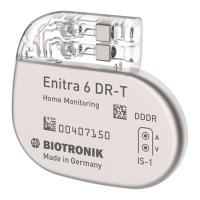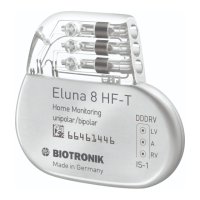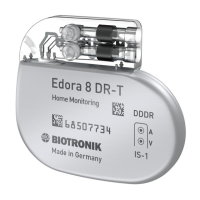Do you have a question about the BIOTRONIK Enticos 4 DR and is the answer not in the manual?
Defines the primary purpose and objectives of the Enticos pacemaker therapy for bradycardia.
Describes functions for synchronizing ventricular contraction in triple-chamber devices.
Explains automatic pacing adjustments for bradycardia treatment.
Specifies environmental and handling conditions for device operation and safety.
Lists potential causes of technical failures in the device system.
Discusses device sensitivity to external electromagnetic interference.
Explains how the device responds to electromagnetic interference.
Lists medical procedures that must be avoided to prevent patient harm or device damage.
Addresses risks associated with electrical current during procedures and necessary precautions.
Explains potential device damage and effects of external defibrillation.
Advises on risks and necessary measures for radiation therapy with implanted devices.
Warns against MRI due to potential device damage and patient harm.
Outlines the steps and preparation required for pacemaker implantation.
Details the process of connecting pacemaker leads to the device header.
Provides instructions to prevent damage to the device header during implantation.
Guides on correctly positioning the programming head for telemetry.
Explains how to establish wireless communication with the programmer.
Describes the automatic initialization process after lead connection.
Explains device behavior during and after auto-initialization.
Specifies follow-up actions after auto-initialization to ensure proper function.
Lists functions to prevent complications like PMT protection.
Highlights critical conditions during tests and the need for patient care.
Details methods to prevent atrial tachycardia conduction to the ventricle.
Advises against setting risky parameter combinations.
Addresses phrenic nerve stimulation during LV pacing and its persistence.
Discusses manual parameter settings and the use of automatic sensitivity.
Warns about risks associated with exclusive LV pacing.
Explains how lead failure is detected through impedance monitoring.
Details parameters for Closed Loop Stimulation (CLS) based on physiological impedance.
| Device Type | Implantable Cardioverter Defibrillator (ICD) |
|---|---|
| Manufacturer | BIOTRONIK |
| Bradycardia Pacing | Yes |
| Tachycardia Detection | Yes |
| MRI Conditional | Yes |
| Pacing Modes | DDD, VVI, AAI |
| Tachycardia Therapy | Anti-tachycardia pacing, cardioversion, defibrillation |
| Remote Monitoring | Yes (BIOTRONIK Home Monitoring) |
| Programming | BIOTRONIK Programmer |
| Defibrillation Energy | Up to 40 Joules |












